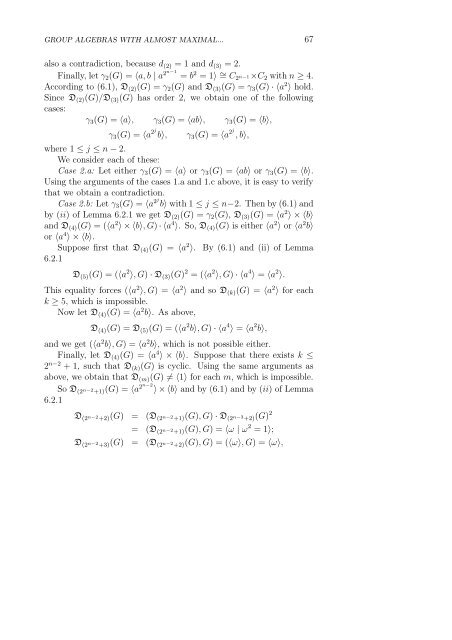On the Derived Length of Lie Solvable Group Algebras
On the Derived Length of Lie Solvable Group Algebras
On the Derived Length of Lie Solvable Group Algebras
Create successful ePaper yourself
Turn your PDF publications into a flip-book with our unique Google optimized e-Paper software.
GROUP ALGEBRAS WITH ALMOST MAXIMAL... 67<br />
also a contradiction, because d(2) = 1 and d(3) = 2.<br />
Finally, let γ2(G) = 〈a, b | a2n−1 = b2 = 1〉 ∼ = C2n−1×C2 with n ≥ 4.<br />
According to (6.1), D(2)(G) = γ2(G) and D(3)(G) = γ3(G) · 〈a2 〉 hold.<br />
Since D(2)(G)/D(3)(G) has order 2, we obtain one <strong>of</strong> <strong>the</strong> following<br />
cases:<br />
γ3(G) = 〈a〉, γ3(G) = 〈ab〉, γ3(G) = 〈b〉,<br />
γ3(G) = 〈a 2j<br />
b〉, γ3(G) = 〈a 2j<br />
, b〉,<br />
where 1 ≤ j ≤ n − 2.<br />
We consider each <strong>of</strong> <strong>the</strong>se:<br />
Case 2.a: Let ei<strong>the</strong>r γ3(G) = 〈a〉 or γ3(G) = 〈ab〉 or γ3(G) = 〈b〉.<br />
Using <strong>the</strong> arguments <strong>of</strong> <strong>the</strong> cases 1.a and 1.c above, it is easy to verify<br />
that we obtain a contradiction.<br />
Case 2.b: Let γ3(G) = 〈a2jb〉 with 1 ≤ j ≤ n−2. Then by (6.1) and<br />
by (ii) <strong>of</strong> Lemma 6.2.1 we get D(2)(G) = γ2(G), D(3)(G) = 〈a2 〉 × 〈b〉<br />
and D(4)(G) = (〈a2 〉 × 〈b〉, G) · 〈a4 〉. So, D(4)(G) is ei<strong>the</strong>r 〈a2 〉 or 〈a2b〉 or 〈a4 〉 × 〈b〉.<br />
Suppose first that D(4)(G) = 〈a2 〉. By (6.1) and (ii) <strong>of</strong> Lemma<br />
6.2.1<br />
D(5)(G) = (〈a 2 〉, G) · D(3)(G) 2 = (〈a 2 〉, G) · 〈a 4 〉 = 〈a 2 〉.<br />
This equality forces (〈a 2 〉, G) = 〈a 2 〉 and so D(k)(G) = 〈a 2 〉 for each<br />
k ≥ 5, which is impossible.<br />
Now let D(4)(G) = 〈a 2 b〉. As above,<br />
D(4)(G) = D(5)(G) = (〈a 2 b〉, G) · 〈a 4 〉 = 〈a 2 b〉,<br />
and we get (〈a2b〉, G) = 〈a2b〉, which is not possible ei<strong>the</strong>r.<br />
Finally, let D(4)(G) = 〈a4 〉 × 〈b〉. Suppose that <strong>the</strong>re exists k ≤<br />
2n−2 + 1, such that D(k)(G) is cyclic. Using <strong>the</strong> same arguments as<br />
above, we obtain that D(m)(G) = 〈1〉 for each m, which is impossible.<br />
So D (2n−2 +1)(G) = 〈a2n−2〉 × 〈b〉 and by (6.1) and by (ii) <strong>of</strong> Lemma<br />
6.2.1<br />
D(2 n−2 +2)(G) = (D(2 n−2 +1)(G), G) · D(2 n−3 +2)(G) 2<br />
= (D (2 n−2 +1)(G), G) = 〈ω | ω 2 = 1〉;<br />
D (2 n−2 +3)(G) = (D (2 n−2 +2)(G), G) = (〈ω〉, G) = 〈ω〉,


